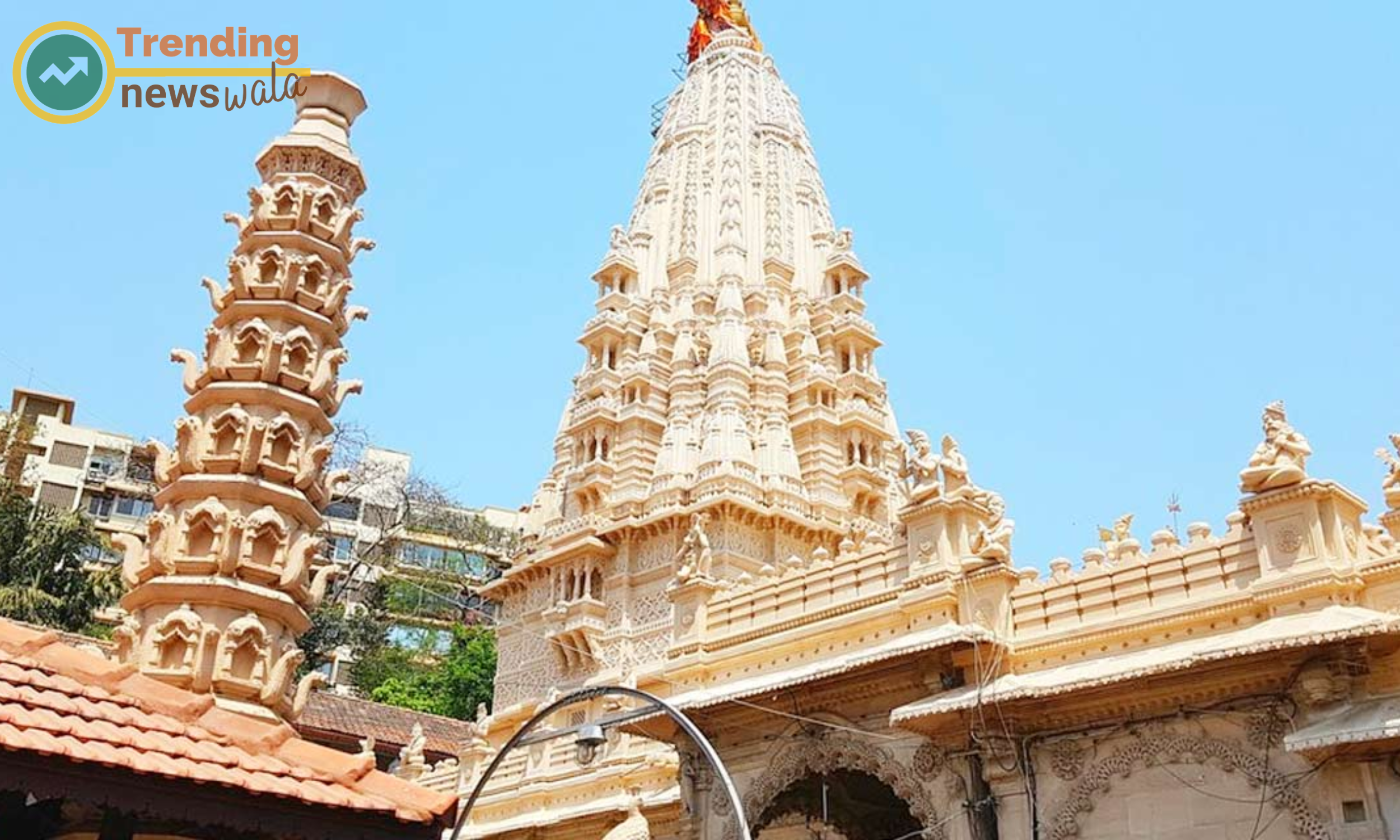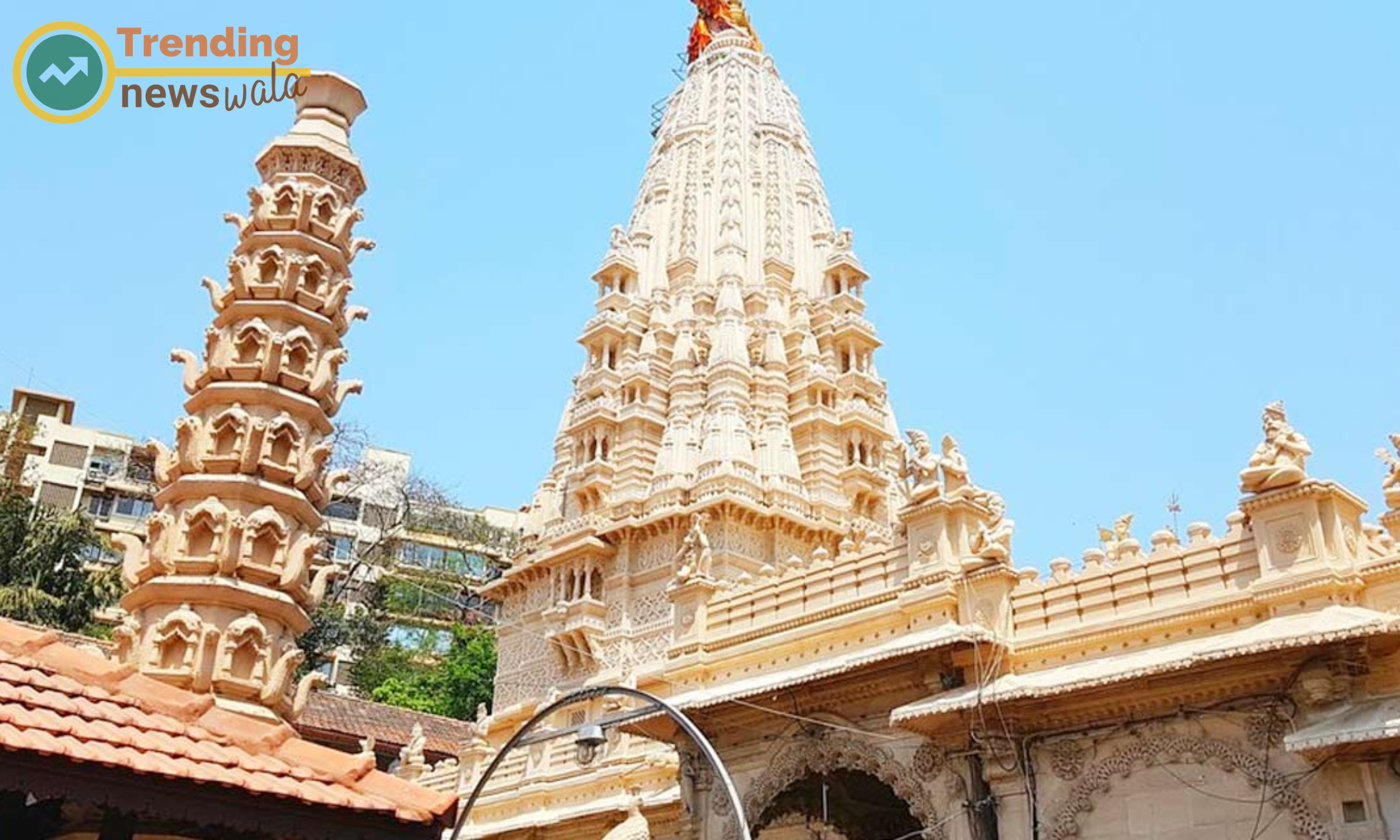Babulnath Shiva Temple
Babulnath Shiva Temple is a cultural, historical, and architectural Temple in Mumbai. Know Everything about the Babulnath Shiva Temple in Mumbai

Nestled in the bustling cityscape of Mumbai, the Babulnath Shiva Temple stands as a serene oasis of spirituality amidst the urban chaos. Dedicated to Lord Shiva, this ancient temple holds not only religious significance but also offers a tranquil escape for devotees seeking solace in the heart of the metropolis. In this article, we explore the history, architecture, and spiritual allure of the Babulnath Shiva Temple.
The Babulnath Shiva Temple stands as a testament to Mumbai's rich cultural and religious diversity. Beyond its historical roots and architectural beauty, the temple provides a haven for spiritual seekers in the heart of a bustling metropolis. As devotees climb the steps to seek the divine blessings of Lord Shiva, the Babulnath Shiva Temple continues to be a beacon of peace and devotion amid the vibrant energy of Mumbai.
Historical Roots

The Babulnath Shiva Temple has a rich history dating back to the 12th century. According to local legends, a cowherd named Babul discovered a naturally occurring Shiva Linga under a babul tree at the current site, leading to the establishment of the temple. Over the centuries, the temple underwent several renovations and enhancements, becoming a prominent center of worship in Mumbai.
The study of history is a journey through time, a quest to understand the origins, evolution, and interconnectedness of human civilizations. The historical roots of societies around the world are deeply embedded in the layers of time, providing valuable insights into the foundations of culture, governance, and human achievements. In this article, we delve into the significance of historical roots and their profound impact on shaping the diverse tapestry of human civilization.
Defining Historical Roots: Historical roots refer to the foundational elements, events, and circumstances that have shaped the course of a civilization or culture. These roots extend far back into the past, influencing the development of traditions, institutions, and societal norms that define a particular community or nation.
Cultural Heritage and Traditions: One of the primary aspects of historical roots is the cultural heritage and traditions passed down through generations. Language, folklore, rituals, and artistic expressions are threads that weave the fabric of a culture, connecting the present to the traditions of the past. Understanding these roots provides insight into the values and beliefs that have endured over centuries.
Foundations of Governance: The historical roots of political systems and governance structures are crucial in understanding the evolution of societies. Concepts of leadership, governance models, and legal frameworks often have deep historical roots that reflect the political philosophies and experiences of earlier generations. Exploring these roots helps trace the trajectory of political thought and the development of governance systems.
Technological and Scientific Advancements: The roots of technological and scientific advancements are embedded in the innovations and discoveries of our ancestors. From ancient tools and agricultural practices to the Industrial Revolution and the digital age, the historical journey of technological progress has transformed the way humans live, work, and communicate.
Economic Systems and Trade Routes: The historical roots of economic systems and trade routes reveal the interconnectedness of civilizations. Ancient trade routes like the Silk Road and maritime routes played a pivotal role in the exchange of goods, ideas, and cultural influences. Understanding these roots sheds light on the economic structures and global relationships that have shaped societies.
Social Structures and Movements: The roots of social structures, hierarchies, and movements provide insights into the dynamics of human relationships. Whether exploring the caste systems of ancient civilizations, the socio-economic changes brought about by the Industrial Revolution, or the civil rights movements of the 20th century, understanding historical roots is essential for comprehending the evolution of social structures and the pursuit of equality.
Impact on Modern Identity: The historical roots of a civilization contribute significantly to its modern identity. Nations often draw upon historical narratives, symbols, and events to shape a sense of collective identity and pride. This connection to the past fosters a shared understanding of heritage, fostering a sense of continuity and belonging.
Preservation and Heritage Conservation: Recognizing the importance of historical roots, efforts are made to preserve and conserve cultural heritage sites, artifacts, and documents. Museums, archaeological excavations, and heritage preservation organizations play a crucial role in safeguarding the tangible and intangible aspects of historical roots for future generations.
Exploring the historical roots of human civilization is a fascinating journey that unveils the stories, struggles, and triumphs of our ancestors. By understanding where we come from, we gain a deeper appreciation for the diverse tapestry of cultures, traditions, and achievements that shape the world today. Historical roots serve as a compass, guiding us through the complexities of the past and providing valuable lessons for the present and future.
Architectural Splendor

The architectural style of the Babulnath Shiva Temple is a blend of classical and contemporary elements. The entrance features intricately carved pillars, and the sanctum sanctorum houses the sacred Shiva Linga, a representation of Lord Shiva. The temple's simplicity and elegance create a serene ambiance that resonates with devotees and visitors alike.
Architecture, the art and science of designing and constructing structures, has been a defining aspect of human civilization for millennia. Architectural splendor, characterized by breathtaking designs, intricate details, and innovative engineering, stands as a testament to the boundless creativity and vision of humanity. In this article, we embark on a journey through the ages to explore the architectural splendors that have left an indelible mark on the world.
Ancient Marvels: The ancient world showcases architectural marvels that continue to captivate and inspire. The Pyramids of Giza, constructed over 4,500 years ago in Egypt, are colossal structures that reflect the precision and sophistication of ancient engineering. The Parthenon in Athens, a masterpiece of classical Greek architecture, is celebrated for its Doric columns and harmonious proportions.
Gothic Grandeur: The Gothic era in medieval Europe witnessed the construction of cathedrals that exemplify architectural splendor. Chartres Cathedral in France, with its soaring pointed arches and stained glass windows, and the Milan Cathedral in Italy, adorned with intricate sculptures and spires, are awe-inspiring examples of Gothic architecture that continue to mesmerize visitors.
Renaissance Opulence: The Renaissance period ushered in a revival of classical forms and a celebration of human achievement. St. Peter's Basilica in Vatican City, designed by Michelangelo and others, is a testament to Renaissance opulence, featuring a magnificent dome and intricate artwork. The Villa Rotonda in Italy, designed by Andrea Palladio, exemplifies the harmony and balance characteristic of Renaissance architecture.
Islamic Architectural Elegance: Islamic architecture, known for its geometric patterns and intricate decorations, has produced architectural marvels across the Islamic world. The Alhambra in Granada, Spain, is renowned for its intricate stucco work, vibrant tiles, and serene courtyards. The Blue Mosque in Istanbul, Turkey, with its cascading domes and six minarets, stands as a masterpiece of Ottoman architecture.
Modern Wonders: The 20th and 21st centuries have given rise to architectural marvels that push the boundaries of design and technology. The Sydney Opera House, with its iconic sail-like structures, is a symbol of modern architectural innovation. The Burj Khalifa in Dubai, currently the world's tallest building, showcases cutting-edge engineering and design.
Sustainable Architecture: In the contemporary era, there is a growing emphasis on sustainable architecture that integrates environmental considerations with aesthetic appeal. The Bosco Verticale (Vertical Forest) in Milan, Italy, features residential towers covered with greenery, contributing to biodiversity and air purification. The Edge in Amsterdam, touted as the greenest building in the world, incorporates sustainable design principles and renewable energy sources.
Cultural Integration: Architectural splendor often reflects the cultural identity of a region. The Taj Mahal in India, a UNESCO World Heritage Site, is a symbol of enduring love and an exquisite blend of Mughal, Persian, and Indian architectural styles. The Forbidden City in Beijing, China, with its intricate palaces and courtyards, reflects traditional Chinese architectural principles.
Preserving Architectural Heritage: Efforts to preserve architectural splendor involve restoration, conservation, and adaptive reuse of historical structures. Organizations such as UNESCO and local heritage conservation groups play a vital role in safeguarding these treasures, ensuring that they endure for future generations.
Architectural splendor is a timeless expression of human creativity, innovation, and cultural identity. From ancient wonders that have withstood the test of time to contemporary structures that redefine skylines, these architectural marvels enrich our world and inspire awe. As architects continue to push the boundaries of design, architectural splendor remains a celebration of human ingenuity, leaving an indelible mark on the landscape of our shared history.
Spiritual Significance

Devotees flock to the Babulnath Shiva Temple to seek the blessings of Lord Shiva, the deity believed to be the harbinger of destruction and regeneration in Hindu mythology. The temple is particularly renowned for its Mahashivratri celebrations, where thousands of devotees participate in night-long prayers and rituals, creating a vibrant and spiritually charged atmosphere.
In the hustle and bustle of our modern lives, the pursuit of spiritual significance provides a profound sanctuary for the soul. Rooted in the timeless quest for meaning and connection, spirituality transcends the material realm, offering a transformative journey that touches the core of human existence. In this exploration, we delve into the multifaceted dimensions of spiritual significance, examining its essence, impact, and the quest for a deeper, more meaningful life.
Defining Spiritual Significance: Spiritual significance is a deeply personal and subjective experience that encompasses the quest for purpose, connection with the divine, and the exploration of inner dimensions of consciousness. It goes beyond religious affiliations, embracing a broader understanding of the sacred and the transcendent in the fabric of human existence.
Connection with the Divine: At the heart of spiritual significance is the pursuit of a connection with the divine, a force or energy greater than ourselves. This may be expressed through organized religions, personal rituals, meditation, or other contemplative practices. The goal is to establish a profound relationship that provides solace, guidance, and a sense of purpose.
Quest for Meaning and Purpose: Spirituality often arises from a yearning for meaning and purpose in life. Individuals seek answers to existential questions, exploring the deeper aspects of their existence and contemplating the significance of their actions. The spiritual journey becomes a quest for a life imbued with purpose beyond the mundane.
Inner Exploration and Self-Discovery: The spiritual path involves a journey inward, a process of self-discovery and inner exploration. Practices such as meditation, mindfulness, and introspection allow individuals to delve into their thoughts, emotions, and beliefs, fostering self-awareness and a deeper understanding of the self.
Morality and Ethical Framework: Spiritual significance is often intertwined with moral and ethical considerations. Many spiritual traditions provide a moral compass, guiding individuals in making ethical decisions and fostering a sense of responsibility towards others. This ethical framework contributes to the development of virtuous and compassionate individuals.
Cultural and Interfaith Dimensions: While spirituality can be deeply personal, it also has cultural and interfaith dimensions. Various cultures and religions offer diverse paths to spiritual significance, each with its unique rituals, practices, and wisdom. Interfaith dialogue emphasizes the shared values and common ground among different spiritual traditions.
Transcendence of Ego and Materialism: A key aspect of spiritual significance involves transcending the ego and detaching from material pursuits. Practices that promote humility, gratitude, and selflessness contribute to the spiritual journey, fostering a shift from the relentless pursuit of worldly possessions toward a deeper, more fulfilling existence.
Unity and Connectedness: Many spiritual traditions emphasize the interconnectedness of all living beings and the unity of existence. Recognizing this interconnectedness fosters a sense of unity and compassion, breaking down the barriers that often divide individuals and communities. Spiritual significance extends beyond individual well-being to encompass the collective good.
Transformation and Growth: Spirituality is a transformative journey that leads to personal growth and evolution. As individuals navigate challenges, setbacks, and triumphs on the spiritual path, they often undergo profound changes in their perspectives, attitudes, and ways of being.
In a world often preoccupied with material pursuits, the pursuit of spiritual significance offers a profound counterbalance. It is a journey that traverses the realms of the sacred, the ethical, and the introspective, providing individuals with a compass to navigate the complexities of human existence. Whether expressed through religious traditions, philosophical reflections, or personal revelations, spiritual significance remains a vital aspect of the human experience, guiding individuals towards a more meaningful and fulfilling life.
Location and Accessibility

Situated on a small hillock in the southern part of Mumbai, near Girgaum Chowpatty, the Babulnath Shiva Temple offers a panoramic view of the cityscape and the Arabian Sea. Its central location makes it easily accessible to locals and tourists alike, providing a tranquil retreat for those seeking a break from the city's hustle and bustle.
In the intricate dance of urban development, the concepts of location and accessibility are foundational pillars that shape the connectivity and functionality of our modern societies. As the world evolves, the strategic positioning of spaces and the ease with which we can reach them play pivotal roles in influencing our daily lives, economic activities, and overall well-being. This article explores the significance of location and accessibility, shedding light on their profound impact on the way we live, work, and interact with the world around us.
Strategic Location: The importance of a strategic location extends beyond geographical coordinates. It encompasses the proximity to essential services, resources, and economic hubs that influence the desirability and functionality of a place. A strategically located area can stimulate economic growth, enhance livability, and attract diverse communities.
Urban Planning and Infrastructure: Cities and urban areas are at the forefront of discussions on location and accessibility. Urban planners meticulously design city layouts, considering factors such as transportation networks, green spaces, and infrastructure development. The strategic positioning of residential, commercial, and recreational spaces shapes the overall flow and rhythm of urban life.
Connectivity through Transportation: Accessibility is intricately tied to transportation, a critical element that determines how easily individuals can reach their desired destinations. Efficient public transportation systems, well-planned road networks, and pedestrian-friendly pathways contribute to enhanced accessibility. Smart city initiatives often focus on optimizing transportation for greater efficiency and sustainability.
Technological Advances: In the digital age, technological advancements further redefine the concepts of location and accessibility. E-commerce platforms, remote work capabilities, and virtual communication tools have transformed traditional ideas about the necessity of physical proximity. The ability to access goods, services, and information from virtually anywhere has expanded our understanding of what it means to be connected.
Economic Impact: The economic impact of location and accessibility is profound. Prime locations, close to business districts or transportation hubs, often command higher property values. Accessibility to markets, suppliers, and a skilled workforce can significantly influence the success and competitiveness of businesses. Consequently, governments and businesses alike invest in improving infrastructure and connectivity to spur economic development.
Cultural and Recreational Hubs: The location of cultural and recreational hubs contributes to the vibrancy and character of a community. The strategic placement of museums, theaters, parks, and entertainment venues fosters a sense of community identity and provides spaces for leisure and social interaction. Such hubs can become focal points that attract residents and visitors alike.
Residential Choices and Livability: For individuals and families, the choice of residence is deeply influenced by location and accessibility. Proximity to schools, healthcare facilities, shopping centers, and recreational spaces shapes the overall quality of life. The concept of "walkability" and the availability of amenities within reach contribute to the desirability of residential areas.
Environmental Considerations: In the context of sustainable development, the location and accessibility of spaces play a crucial role in mitigating environmental impact. Well-planned urban development can reduce the need for extensive commuting, leading to lower carbon emissions. Green spaces strategically located within urban areas contribute to environmental sustainability and overall well-being.
Challenges and Solutions: While strategic location and accessibility are pivotal, challenges such as urban sprawl, traffic congestion, and unequal distribution of resources persist. Sustainable urban planning, investment in public transportation, and the integration of technology solutions are among the strategies employed to address these challenges and create more inclusive, connected communities.
In the tapestry of our interconnected world, location and accessibility emerge as crucial threads that weave together the fabric of our daily lives. Whether influencing economic vitality, cultural richness, or individual well-being, the strategic placement of spaces and the ease with which we navigate them are instrumental in shaping the present and future of our communities. As we continue to evolve, the thoughtful consideration of location and accessibility will remain paramount in building resilient, thriving, and inclusive societies.
Cultural Festivals and Events

Apart from Mahashivratri, the temple also celebrates other Hindu festivals with enthusiasm, drawing people from various communities. The rhythmic sounds of bhajans (devotional songs) and the fragrance of incense permeate the air during these festivities, creating an atmosphere of devotion and celebration.
Cultural festivals and events serve as vibrant tapestries woven with the threads of tradition, heritage, and collective joy. These celebrations bring communities together, providing a platform to showcase and preserve cultural diversity. In this article, we explore the significance of cultural festivals and events, their impact on fostering unity, and the invaluable role they play in preserving and promoting cultural heritage.
Preserving Cultural Heritage: Cultural festivals and events serve as living repositories of traditions, customs, and artistic expressions passed down through generations. Whether celebrating religious rituals, folklore, or historical events, these occasions become stages where cultural heritage is preserved and proudly displayed. Through dance, music, rituals, and art, communities transmit their unique identities to future generations.
Fostering Unity and Community Spirit: One of the primary roles of cultural festivals is to foster unity and strengthen community bonds. These events provide opportunities for people to come together, transcending differences and celebrating shared traditions. Whether within a small village or on a global scale, the communal spirit generated by cultural festivals reinforces a sense of belonging and interconnectedness.
Showcasing Artistic Expressions: Cultural festivals are a celebration of artistic diversity, showcasing a myriad of creative expressions. From traditional dances and music to contemporary art installations, these events serve as platforms for artists to exhibit their talents. The fusion of traditional and modern elements often results in dynamic and innovative presentations that captivate audiences and contribute to the evolution of cultural expressions.
Promoting Cultural Exchange: In an era characterized by globalization, cultural festivals and events play a pivotal role in promoting cross-cultural exchange. These celebrations invite people from different backgrounds to immerse themselves in the richness of diverse traditions, fostering understanding and appreciation for the cultural tapestry that makes up our global community. International festivals provide a melting pot where attendees can experience the world's cultures in one location.
Economic and Tourism Impact: Cultural festivals have substantial economic and tourism benefits for communities. Local businesses often flourish during these events as vendors, artisans, and food establishments experience increased patronage. Moreover, cultural festivals attract tourists who seek authentic experiences, contributing to the economic growth of the hosting region.
Educational Opportunities: Cultural festivals serve as valuable educational resources, offering insights into the history, customs, and beliefs of different communities. Visitors have the opportunity to engage with cultural exhibits, attend workshops, and participate in interactive experiences that deepen their understanding of diverse cultures. This educational aspect helps break down stereotypes and promotes a more inclusive society.
Preservation of Endangered Traditions: For many communities, cultural festivals become a lifeline for the preservation of endangered traditions. Rituals, crafts, and practices that may be fading away due to modernization find renewed appreciation during these celebrations. The attention garnered during festivals often sparks interest in traditional practices, leading to increased efforts to safeguard cultural heritage.
Environmental Considerations: In recent years, there has been a growing awareness of the environmental impact of large-scale events. Cultural festivals are adapting to incorporate eco-friendly practices, emphasizing sustainability and responsible event management. From waste reduction initiatives to eco-conscious designs, these efforts ensure that cultural celebrations contribute positively to the environment.
Challenges and Adaptations: While cultural festivals are essential for celebrating diversity, they also face challenges such as commercialization, cultural appropriation, and the need for inclusive representation. Organizers are adapting by promoting ethical practices, fostering inclusivity, and ensuring that festivals remain true to their cultural roots.
Cultural festivals and events serve as powerful catalysts for celebrating diversity, preserving heritage, and fostering a sense of community. As these celebrations continue to evolve, embracing inclusivity, sustainability, and innovation, they play an instrumental role in shaping a global society that values and cherishes the richness of cultural expression. Through the vibrant tapestry of festivals, humanity finds common ground and embraces the kaleidoscope of traditions that make our world a truly interconnected and harmonious place.
Community Engagement

The Babulnath Shiva Temple actively engages with the local community, organizing charitable events, educational programs, and medical camps. The temple serves as a hub for cultural and spiritual activities, fostering a sense of unity and goodwill among its devotees.
Community engagement stands as a cornerstone in the foundation of strong and interconnected societies. It embodies the collective efforts of individuals, organizations, and local authorities to actively participate in the well-being and development of their communities. In this article, we delve into the multifaceted dimensions of community engagement, exploring its significance, impact, and the transformative power it holds in fostering a sense of unity and resilience.
Defining Community Engagement: Community engagement is a dynamic and participatory process that involves individuals and groups actively contributing to the development and improvement of their local communities. It goes beyond mere involvement or consultation; it embraces collaboration, shared decision-making, and a sense of collective responsibility for the welfare of the community.
Fostering Inclusivity and Diversity: At the heart of community engagement is the commitment to inclusivity and diversity. Engaged communities celebrate the richness of their diversity, valuing the perspectives and contributions of individuals from different backgrounds. Inclusivity ensures that everyone feels heard and represented, creating a sense of belonging that strengthens the social fabric.
Local Governance and Decision-Making: Community engagement plays a pivotal role in local governance, empowering residents to actively participate in decision-making processes. Participatory budgeting, community forums, and citizen advisory boards are examples of initiatives that enable community members to have a direct impact on policies, projects, and resource allocation in their neighborhoods.
Collaboration Between Residents and Authorities: Effective community engagement involves collaboration between residents and local authorities. Open communication channels, transparency in decision-making, and initiatives that seek community input create a symbiotic relationship where both residents and authorities work together for the greater good. This collaborative approach builds trust and fosters a sense of shared responsibility.
Social and Economic Development: Community engagement is a catalyst for social and economic development. Through collaborative efforts, communities can identify their needs and priorities, leading to the development of targeted programs and initiatives. These may include infrastructure projects, educational programs, job training, and economic revitalization efforts that directly address the community's challenges and aspirations.
Crisis Response and Resilience: During times of crisis, whether natural disasters or public health emergencies, community engagement becomes even more crucial. Engaged communities demonstrate resilience as members come together to support one another, share resources, and collectively navigate challenges. Local organizations and volunteers often play pivotal roles in providing assistance and coordinating relief efforts.
Empowering Grassroots Initiatives: Community engagement empowers grassroots initiatives and local leaders who intimately understand the needs and aspirations of their communities. These initiatives, whether focused on environmental sustainability, health and wellness, or cultural enrichment, contribute to the vibrancy and resilience of the community.
Education and Skill Development: Engaged communities prioritize education and skill development initiatives that empower residents to thrive and contribute meaningfully. Programs ranging from adult education classes to vocational training opportunities equip individuals with the skills needed to enhance their employability and overall well-being.
Promoting Civic Responsibility: Community engagement nurtures a culture of civic responsibility where individuals actively contribute to the betterment of society. Through volunteering, participating in community events, and supporting local causes, residents develop a sense of ownership and pride in their communities.
Challenges and Solutions: While community engagement is transformative, it does face challenges such as apathy, communication barriers, and resource constraints. Solutions involve implementing effective communication strategies, leveraging technology for outreach, and fostering a culture of active citizenship through education and awareness campaigns.
Community engagement is a powerful force that transforms neighborhoods into thriving, connected hubs of activity. As individuals and organizations actively participate in the shaping of their communities, the ripple effects are felt in social cohesion, economic development, and overall well-being. Through a shared commitment to inclusivity, collaboration, and civic responsibility, communities can harness the strength of engagement to build a resilient and vibrant future for all.
Preservation and Conservation

Efforts have been made to preserve and conserve the historical and cultural significance of the Babulnath Shiva Temple. Renovation projects aim to maintain the temple's structural integrity while ensuring that its spiritual essence remains intact for future generations.
Preservation and conservation stand as noble endeavors dedicated to safeguarding the treasures of our cultural and natural heritage. In a world marked by rapid development and environmental challenges, the importance of these efforts cannot be overstated. This article explores the significance of preservation and conservation, their impact on cultural artifacts and ecosystems, and the collective responsibility to ensure the sustainability of our planet for future generations.
Cultural Heritage Preservation: Preservation in the context of cultural heritage refers to the protection and maintenance of artifacts, buildings, documents, and traditions that hold historical and cultural significance. Museums, archives, and heritage organizations play pivotal roles in preserving tangible and intangible elements of our past. This encompasses everything from ancient manuscripts and artworks to architectural marvels and traditional crafts.
The Role of Museums and Archives: Museums and archives serve as custodians of our collective history, preserving artifacts and documents that tell the story of human civilization. Through meticulous curation, conservation practices, and public exhibitions, these institutions contribute to the education and appreciation of cultural heritage. The conservation of delicate artworks, manuscripts, and archaeological finds requires specialized knowledge and techniques to ensure their longevity.
Heritage Sites and Monuments: Preservation efforts extend to heritage sites and monuments that bear witness to the architectural and cultural achievements of past civilizations. UNESCO World Heritage Sites, such as the Pyramids of Giza or the Taj Mahal, represent international commitments to safeguarding these landmarks for future generations. Restoration projects, guided by principles of authenticity and minimal intervention, aim to revitalize these sites while preserving their historical integrity.
Intangible Cultural Heritage: Preserving intangible cultural heritage involves safeguarding traditions, rituals, languages, and knowledge systems passed down through generations. Initiatives to document and revitalize endangered languages, traditional crafts, and folk performances contribute to the preservation of the diverse cultural tapestry that enriches our global society.
Environmental Conservation: In the realm of environmental conservation, the focus shifts to protecting ecosystems, wildlife, and natural resources. This involves sustainable practices, habitat restoration, and the mitigation of human activities that threaten biodiversity. Conservation efforts are essential to maintaining the delicate balance of ecosystems and addressing the challenges posed by climate change, deforestation, and pollution.
Biodiversity and Wildlife Conservation: Preserving biodiversity is a cornerstone of environmental conservation. Ecosystems are intricately connected, and the loss of one species can have cascading effects. Conservation initiatives target endangered species, establish protected areas, and implement measures to combat poaching and illegal wildlife trade. Zoos and wildlife sanctuaries also contribute to the preservation of endangered species through captive breeding and educational programs.
Sustainable Practices and Resource Management: Promoting sustainable practices is essential for the responsible management of natural resources. This includes sustainable agriculture, forestry, and fisheries that prioritize long-term environmental health over short-term gains. Conservation-minded practices aim to reduce carbon emissions, limit waste, and promote the efficient use of resources to mitigate the impact of human activities on the planet.
Global Collaboration for Conservation: Preservation and conservation efforts are increasingly recognized as global responsibilities that require collaborative action. International agreements and organizations, such as the Paris Agreement on climate change and the Convention on Biological Diversity, aim to unite nations in a common commitment to environmental sustainability. Cross-border collaboration is crucial for addressing issues that transcend national boundaries.
Challenges and Solutions: Preservation and conservation face numerous challenges, including inadequate funding, climate change, and the ever-present threat of illicit trade in cultural artifacts and wildlife. Solutions involve increased public awareness, policy advocacy, sustainable development practices, and the leveraging of technology for monitoring and enforcement.
Preservation and conservation are intertwined threads that weave the fabric of a sustainable and culturally rich world. Whether safeguarding ancient manuscripts, protecting endangered species, or advocating for sustainable development, these efforts are grounded in the collective responsibility to be stewards of our planet. As we navigate the complexities of a rapidly changing world, the commitment to preservation and conservation remains a beacon of hope, ensuring that the legacy we leave for future generations is one of cultural richness, biodiversity, and environmental sustainability.





